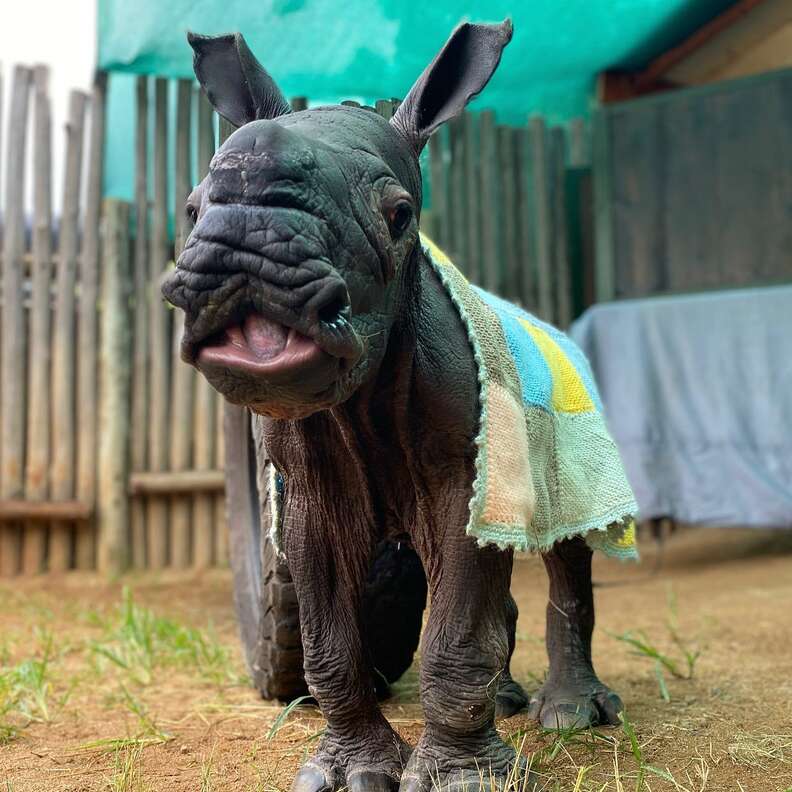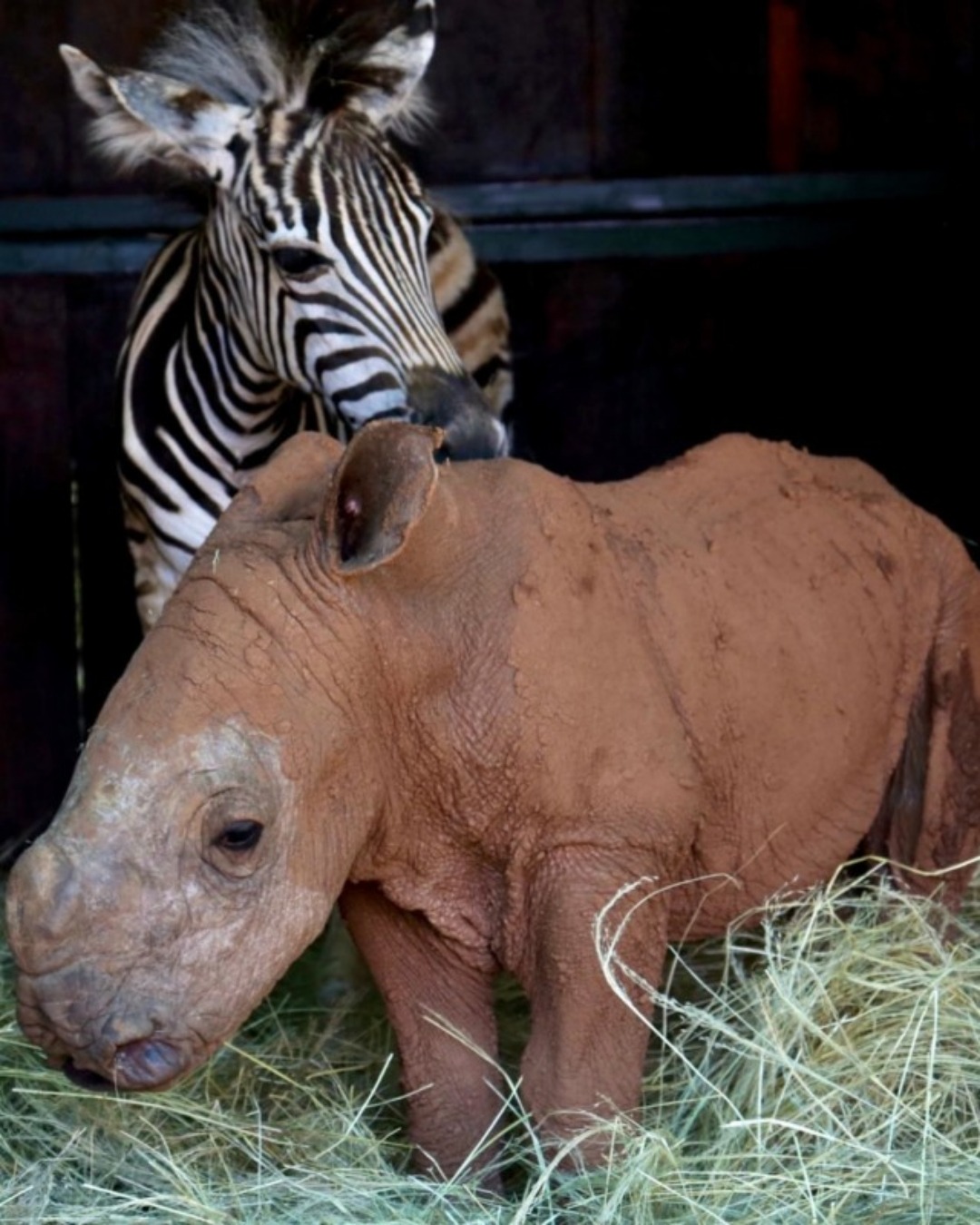The early morning haze drifted across the South African grasslands as caretakers at a wildlife sanctuary prepared for another day of tending to young animals in need. In the quiet stillness, the gentle rustle of straw and the soft shuffle of tiny hooves carried through the intensive care unit. Two small shapes rested side by side, breathing in calm, steady rhythm. One was a newborn rhino, still round and sleepy-eyed, her skin a soft gray hue. The other was a zebra foal, all long legs and delicate stripes, curled in close as if she had always belonged there.

No one could have predicted that two orphans—each arriving under different circumstances—would form a friendship strong enough to inspire people far beyond the sanctuary’s borders. Yet their companionship has become more than just a feel-good story. For many, their connection represents the mysteries of animal behavior, the cultural symbolism humans attach to wildlife, and the scientific curiosity sparked by unexpected bonds between species.
Their names are Daisy and Modjadji, and this is their story.
A Beginning Shaped by Uncertainty
In early December, rangers at Kruger National Park discovered a newborn rhino calf wandering alone. She was only hours old and struggling to stand, her tiny body trembling from exhaustion. With no mother nearby, the calf was brought to the Care For Wild Rhino Sanctuary, a place known for its dedication to helping vulnerable young animals stabilize and grow strong.
The team named her Daisy. She needed constant care—frequent bottle feedings, warm blankets, and close monitoring to ensure her body temperature and strength continued to rise. Despite the team’s commitment, Daisy lacked something many young rhinos rely on deeply: companionship.
Social bonds are essential in rhino development, helping young calves feel secure, regulate stress, and learn early behaviors. Without another animal beside her, Daisy’s healing journey would be missing an important piece.
What no one expected was that the missing piece had already arrived at the sanctuary a week earlier.

The Arrival of Modjadji the Zebra
Before Daisy came into the caretakers’ lives, another newborn animal had survived a different kind of struggle. A tiny zebra foal had been found after powerful storms swept across the reserve. She was lying still on the ground, exhausted after being separated from her mother. Sanctuary staff transported the foal to the intensive care area, where she slowly began to regain her strength.
The staff named her Modjadji. Her progress was steady but slow, and like Daisy, she needed companionship. While zebras are known for their strong herd dynamics, young foals especially bond closely with their mothers or another protective adult. Being alone, even when well cared for, left Modjadji without the reassurance most young animals need.
With both Daisy and Modjadji settling into recovery, their caretakers kept them in separate areas at first. It was important for each to stabilize before any interactions. Yet as they grew stronger, something remarkable—and almost magical—began to unfold.

From Curiosity to Companionship
As the days passed, the two orphans began to notice each other across the ICU space. At first, their interactions were small: a quiet sniff, a soft glance, or a slow step toward the other’s corner. Sanctuary staff noted these subtle exchanges but gave the young animals time to explore at their own pace.
Then one morning, caretakers found Daisy standing near Modjadji’s enclosure, gently nudging the barrier. In return, the zebra foal stretched her neck through the opening, touching her muzzle to Daisy’s face. These small gestures were signs of trust, and the staff realized a new bond was forming.
Soon, the young animals began spending time together under supervision. Daisy followed Modjadji with careful steps, and Modjadji remained close to Daisy as if guiding her through unfamiliar surroundings. What started with cautious movements quickly transformed into friendship.
Louwhen Bowker, a media representative for the sanctuary, noted that rhinos naturally seek companionship. Modjadji’s calm presence offered Daisy comfort, while Daisy’s slow, steady movements gave Modjadji reassurance. Their interactions became a daily rhythm—eating near each other, resting together, and exploring side by side as their confidence grew.

Why Do Animals Form Cross-Species Bonds?
Stories like Daisy and Modjadji’s often spark debates between myth and scientific interpretation. Throughout history, cultural storytelling has featured friendships between different species, symbolizing unity, harmony, or the idea that nature itself finds balance in unexpected ways. In many African traditions, animals are seen as carriers of lessons or symbols of resilience. A rhino, often viewed as a symbol of strength and determination, paired with a zebra, associated with balance and community, creates a narrative that feels almost poetic.
From a scientific perspective, cross-species bonds—though not typical—are not entirely surprising. Researchers suggest several explanations:
Young animals may imprint on nearby companions when their biological parents are absent.
Shared early-life stress or similar recovery experiences can lead to social bonding.
Consistent care from humans creates a safe environment where animals feel secure enough to form additional relationships.
Some scientists also propose that young animals are more flexible in their social behaviors, allowing them to trust and connect with unfamiliar species during vulnerable stages of life.
Though these explanations offer insight, each bond is unique. And while we cannot fully understand the emotional depth behind Daisy and Modjadji’s connection, their friendship reminds us that nature often behaves in ways that inspire both fascination and wonder.
Healing Through Togetherness
For the sanctuary team, the bond was not just heartwarming—it was beneficial. Without a companion, Daisy might become overly attached to her human caretakers, making it harder to transition her back into the wild. With Modjadji by her side, Daisy learned to socialize in ways that support her natural development.
The two grew more confident day by day. Daisy’s steps became stronger and steadier, while Modjadji’s playful energy encouraged her rhino companion to explore more freely. They rested close together at night and enjoyed the comfort of having someone familiar nearby.
This companionship helped reduce stress for both animals, creating a stable emotional environment that supported their recovery. While the sanctuary acknowledges the science behind such bonds, they also recognize the simple beauty of watching two young animals find comfort in each other’s presence.

A Future Beyond the Sanctuary
As Daisy and Modjadji continue to grow, their paths will eventually diverge. Daisy will join other rhinos in preparation for reintroduction into the wild, while Modjadji will one day become part of a zebra herd. Although they will not walk the same path forever, their shared beginnings have strengthened them in ways that will support their future journeys.
Staff at the sanctuary emphasize that the animals’ well-being and independence are their top priorities. While their friendship may evolve as they mature, the early bond they formed has already shaped their development in meaningful ways.
For now, Daisy and Modjadji continue to share their days at the sanctuary, moving through their routines with a companion who understands their past hardships and present hopes.
Cultural Reflections and Scientific Curiosity
The story of Daisy and Modjadji has circulated widely, capturing the attention of readers around the world. Some interpret their bond through cultural symbolism: two different beings united not by appearance or species, but by the universal need for connection.
Others view the story through the lens of biology, interested in how cross-species companionship can support emotional regulation, recovery, and growth. While scientific studies continue to explore these relationships, stories like this one remind us how much we still have to learn about animal behavior.
Both perspectives—cultural and scientific—offer valuable ways of understanding the world. When combined, they create a richer appreciation for moments of connection that might otherwise go unnoticed.
A Gentle Reminder of Our Shared Curiosity
In a world filled with questions about how nature operates and why certain bonds form, Daisy and Modjadji offer a quiet reminder of the beauty that emerges when lives intersect in unexpected ways. Their friendship invites us to remain curious, to observe without assumption, and to reflect on the many different forms companionship can take.
Their story is not one of certainty but of discovery—a reminder that even in challenging circumstances, connection can become a source of healing.
And perhaps that is why this gentle tale resonates with so many people. At its heart, it speaks to something universal: the hope that even in moments of uncertainty, friendship can grow where we least expect it. It encourages us to keep exploring, keep learning, and continue nurturing our curiosity about the world around us.
Sources
Daily.tiemgo.vn – The Orphaned Rhino and Zebra Who Found Family in Each Other
Care For Wild Rhino Sanctuary – Official communications and educational resources
Kruger National Park – Wildlife conservation information and ranger reports
